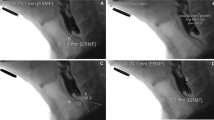Abstract
Bolus residue is significant risk factor for postswallow aspiration. A retrospective study was performed to evaluate the role of bolus residue and its relation with respiratory problems in children with esophageal atresia. Children were evaluated for demographic features, type of esophageal atresia, associated anomalies, and respiratory problems. The videofluoroscopic swallowing evaluation (VFSE) was performed, and scored by using the penetration aspiration scale (PAS), bolus residual score (BRS) and normalized residual ratio scale (NRRS). Children with and without respiratory problems were also compared in terms of aspiration and bolus residue. Forty-one children with a median age of 15 months (1–138 months), male:female ratio of 26:15 was included. 65.9% (n = 27) of children were type-C and 24.4% (n = 10) were type-A EA. In 61% (n = 25) of children had liquid aspiration (PAS ≥ 6) and 9.8% (n = 4) had aspiration in pudding consistencies. Children with aspiration in liquids had significantly higher NRRS and BRS scores in vallecular residue for pudding consistencies when compared to children without aspiration (p < 0.05). No difference was detected in terms of PAS scores and bolus residual parameters between children with and without respiratory problems (p > 0.05). Children with aspiration in liquids have higher scores of BRS and NRRS at the level of vallecular especially in pudding consistencies. VFSE findings for bolus residue did not show significant relation with respiratory problems. Respiratory morbidity in children with EA is multifactorial and may not only explained by bolus residuals and aspiration.
Similar content being viewed by others
References
Yalcin S, Demir N, Serel S, Soyer T, Tanyel FC. The evaluation of deglutition with videofluoroscopy after repair of esophageal atresia and/or tracheoesophageal fistula. J Pediatr Surg. 2015;50:1823–7. https://doi.org/10.1016/j.jpedsurg.2015.07.002.
Kovesi T. Aspiration risk and respiratory complications in patients with esophageal atresia. Front Pediatr. 2017;3(5):62. https://doi.org/10.3389/fped.2017.00062.
Tuğcu GD, Soyer T, Polat SE, Hizal M, Emiralioğlu N, Yalçın E, Doğru D, Kiper N, Özçelik U. Evaluation of pulmonary complications and affecting factors in children for repaired esophageal atresia and tracheoesophageal fistula. Respir Med. 2021;181:106376. https://doi.org/10.1016/j.rmed.2021.106376.
Hörmann M, Pokieser P, Scharitzer M, et al. Videofluoroscopy of deglutition in children after repair of esophageal atresia. Acta Radiol. 2002;43:507–10.
Mahoney L, Rosen R. Feeding problems and their underlying mechanisms in the esophageal atresia-tracheoesophageal fistula patient. Front Pediatr. 2017;31(5):127. https://doi.org/10.3389/fped.2017.00127.
Rommel N, Borgers C, Van Beckevoort D, Goeleven A, Dejaeger E, Omari TI. Bolus residue scale: an easy-to-use and reliable videofluoroscopic analysis tool to score bolus residue in patients with dysphagia. Int J Otolaryngol. 2015. https://doi.org/10.1155/2015/780197.
Eisenhuber E, Schima W, Schober E, Pokieser P, Stadler A, Scharitzer M, Oschatz E. Videofluoroscopic assessment of patients with dysphagia: pharyngeal retention is a predictive factor for aspiration. AJR Am J Roentgenol. 2002;178(2):393–8. https://doi.org/10.2214/ajr.178.2.1780393.
Pearson WG Jr, Molfenter SM, Smith ZM, Steele CM. Image-based measurement of post-swallow residue: the normalized residue ratio scale. Dysphagia. 2013;28(2):167–77. https://doi.org/10.1007/s00455-012-9426-9.
Soyer T, Arslan SS, Boybeyi Ö, Demir N, Tanyel FC. The role of oral feeding time and sham feeding on oropharyngeal swallowing functions in children with esophageal atresia. Dysphagia. 2022. https://doi.org/10.1007/s00455-022-10461-1.
Hiorns MP, Ryan MM. Current practice in paediatric videofluoroscopy. Pediatr Radiol. 2006;36(9):911–9. https://doi.org/10.1007/s00247-006-0124-3.
DeMatteo C, Matovich D, Hjartarson A. Comparison of clinical and videofluoroscopic evaluation of children with feeding and swallowing difficulties. Dev Med Child Neurol. 2005;47(3):149–57. https://doi.org/10.1017/s0012162205000289.
Rosenbek JC, Robbins JA, Roecker EB, Coyle JL, Wood JL. A penetration-aspiration scale. Dysphagia. 1996;11(2):93–8. https://doi.org/10.1007/bf00417897.
Karaduman A, Serel S, Ünlüer Ö, Demir N. The penetration aspiration scale: an interrater reliability study. Fizyoter Rehabil. 2012;23(3):151–5. https://doi.org/10.1007/bf00417897.
Molfenter SM, Steele CM. The relationship between residue and aspiration on the subsequent swallow: an application of the normalized residue ratio scale. Dysphagia. 2013;28(4):494–500. https://doi.org/10.1007/s00455-013-9459-8.
Demir N, Arslan SS, Yalcin S, Karaduman A, Tanyel FC, Soyer T. Alterations in hyolaryngeal elevation after esophageal anastomosis: a possible mechanism for airway aspiration. J Pediatr Surg. 2017;52(10):1580–2. https://doi.org/10.1016/j.jpedsurg.2017.04.001.
Author information
Authors and Affiliations
Corresponding author
Additional information
Publisher's Note
Springer Nature remains neutral with regard to jurisdictional claims in published maps and institutional affiliations.
Rights and permissions
Springer Nature or its licensor (e.g. a society or other partner) holds exclusive rights to this article under a publishing agreement with the author(s) or other rightsholder(s); author self-archiving of the accepted manuscript version of this article is solely governed by the terms of such publishing agreement and applicable law.
About this article
Cite this article
Soyer, T., Arslan, S.S., Pişiren, B. et al. The Role of Bolus Residue and Its Relation with Respiratory Problems in Children with Esophageal Atresia. Dysphagia 38, 1546–1550 (2023). https://doi.org/10.1007/s00455-023-10582-1
Received:
Accepted:
Published:
Issue Date:
DOI: https://doi.org/10.1007/s00455-023-10582-1




